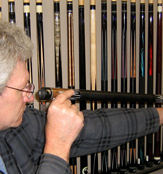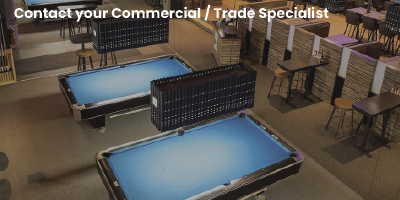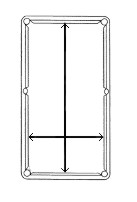How to Check a Pool Cue for Warping
John Roufas2023-09-29T23:11:58-04:00How to Check a Pool Cue for Warping

Testing a pool cue to see if it is warped is one of the easier tasks for a pool player to do. There are a few different ways to check a cue for straightness, but by far the most popular and reliable way to see if your cue is straight is to “sight” the cue.
To sight a cue, hold it up at eye level and look down the cue from the butt, as if you were shooting a rifle. Hold the cue out and slightly downward, slowly turning the cue 360 degrees as you look down the cue from the butt to the tip.
Some people will tell you to roll your cue to check for warping; however this is not the most reliable way to check a cue for straightness. In order for the roll test to work, you need to find a perfectly flat surface. Pool tables are not ideal for this sort of test as even the slightest variation in cloth or table felt can cause your cue to wobble a little when you roll it (even if your cue is straight).
Cues also have different tapers and are not conical; the diameter of the cue varies down its length. This taper can cause the cue to wobble when rolled. Cues also often have joints, price stickers, weight stickers or marketing stickers on them, all of which will affect the roll of a cue. Therefore, sighting your cue is the most reliable way to check for warping.
All cues have some variation in the straightness and roundness of the cue. Remember that cues are made from a natural product and are affected by their surroundings. Humidity and temperature will always affect a piece of wood. Even the most expensive cues are not perfectly straight.
Whenever you buy a pool cue, the first thing you should do is sight it to make sure it is not warped, start playing and shoot well. However, if you notice a significant warp, call before chalking or scuffing the cue in order to arrange a replacement. We cannot replace cues that have already been chalked, shaped, or otherwise played with.
Keeping a Cue Straight
These guidelines should help keep your cue as straight as possible, but remember, most cues are wood, and wood is a natural material that naturally warps. In almost every instance, there is no warranty guaranteeing that a cue will stay straight. If this is a concern, consider trying a warp-resistant cue material, such as carbon graphite or fiberglass wrapped cues.
The Do's
- Keep your cue in a padded or polyform cue case when not in use. This will help to protect it and prevent possible damage.
- Try to keep your cue in a stable environment. Avoid extreme changes in temperature and/or humidity whenever possible.
The Don’ts
- Lean your cue against a wall, or leave it near heat, e.g. a radiator or fireplace. This is a sure-fire way of warping your cue!
- Lean on your cue between shots. You’re changing the shape of the cue.
- Leave your cue in your car, or anywhere else that is likely to get cold or damp. This can cause the cue to ‘sweat’ and this is the biggest cause of warped cues. It also can cause any glue joins to separate, and inlays to rise.
- Avoid sanding or using steel wool on your cue shaft to clean it. This opens up the pores in the wood, allowing moisture and dirt to penetrate more easily. After cleaning a cue, you should always reseal the wood by burnishing with leather and/or treating it with a cue shaft sealant or wax. See F.G.Bradley’s Cue Maintenance.
Always bear in mind that the cue can still move a little no matter how well you look after it. A cue is made of natural products and changes with variations in the environment. Every piece of wood and, therefore, cue has its own personality.





